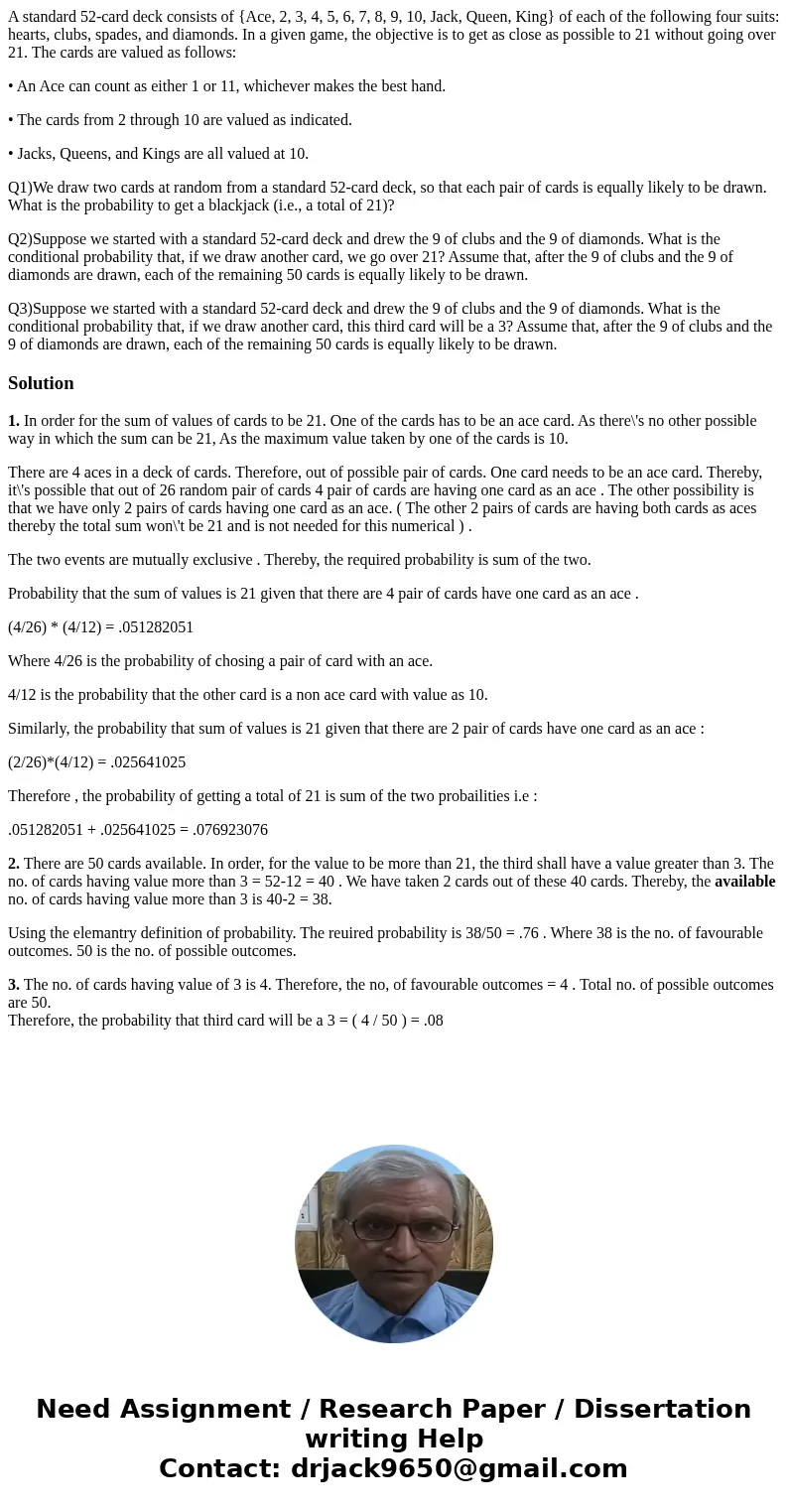A standard 52card deck consists of Ace 2 3 4 5 6 7 8 9 10 Ja
A standard 52-card deck consists of {Ace, 2, 3, 4, 5, 6, 7, 8, 9, 10, Jack, Queen, King} of each of the following four suits: hearts, clubs, spades, and diamonds. In a given game, the objective is to get as close as possible to 21 without going over 21. The cards are valued as follows:
• An Ace can count as either 1 or 11, whichever makes the best hand.
• The cards from 2 through 10 are valued as indicated.
• Jacks, Queens, and Kings are all valued at 10.
Q1)We draw two cards at random from a standard 52-card deck, so that each pair of cards is equally likely to be drawn. What is the probability to get a blackjack (i.e., a total of 21)?
Q2)Suppose we started with a standard 52-card deck and drew the 9 of clubs and the 9 of diamonds. What is the conditional probability that, if we draw another card, we go over 21? Assume that, after the 9 of clubs and the 9 of diamonds are drawn, each of the remaining 50 cards is equally likely to be drawn.
Q3)Suppose we started with a standard 52-card deck and drew the 9 of clubs and the 9 of diamonds. What is the conditional probability that, if we draw another card, this third card will be a 3? Assume that, after the 9 of clubs and the 9 of diamonds are drawn, each of the remaining 50 cards is equally likely to be drawn.
Solution
1. In order for the sum of values of cards to be 21. One of the cards has to be an ace card. As there\'s no other possible way in which the sum can be 21, As the maximum value taken by one of the cards is 10.
There are 4 aces in a deck of cards. Therefore, out of possible pair of cards. One card needs to be an ace card. Thereby, it\'s possible that out of 26 random pair of cards 4 pair of cards are having one card as an ace . The other possibility is that we have only 2 pairs of cards having one card as an ace. ( The other 2 pairs of cards are having both cards as aces thereby the total sum won\'t be 21 and is not needed for this numerical ) .
The two events are mutually exclusive . Thereby, the required probability is sum of the two.
Probability that the sum of values is 21 given that there are 4 pair of cards have one card as an ace .
(4/26) * (4/12) = .051282051
Where 4/26 is the probability of chosing a pair of card with an ace.
4/12 is the probability that the other card is a non ace card with value as 10.
Similarly, the probability that sum of values is 21 given that there are 2 pair of cards have one card as an ace :
(2/26)*(4/12) = .025641025
Therefore , the probability of getting a total of 21 is sum of the two probailities i.e :
.051282051 + .025641025 = .076923076
2. There are 50 cards available. In order, for the value to be more than 21, the third shall have a value greater than 3. The no. of cards having value more than 3 = 52-12 = 40 . We have taken 2 cards out of these 40 cards. Thereby, the available no. of cards having value more than 3 is 40-2 = 38.
Using the elemantry definition of probability. The reuired probability is 38/50 = .76 . Where 38 is the no. of favourable outcomes. 50 is the no. of possible outcomes.
3. The no. of cards having value of 3 is 4. Therefore, the no, of favourable outcomes = 4 . Total no. of possible outcomes are 50.
Therefore, the probability that third card will be a 3 = ( 4 / 50 ) = .08

 Homework Sourse
Homework Sourse